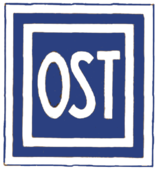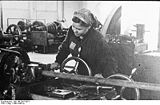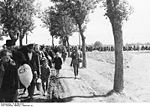
German Ost (East)
Encyclopedia
This article deals with German colonization of parts of Eastern Europe during the late nineteenth through twentieth centuries. For an article on the medieval migration of Germans into eastern Europe, see Ostsiedlung
.
Germany's colonial expansion in the late nineteenth century encompassed not only Africa and the South Pacific, but Eastern Europe. German settlements were created in Prussia
in the late 1880s; Germany joined forces with those involved in trying to create an "independent Ukraine" in 1918; and in 1939 Germany established the Reichsgau Wartheland
in areas that roughly corresponded to Poland, Lithuania, Latvia and the Ukraine. (At various times historically parts of the Ukraine had been part of Poland, part of Lithuania, part of the Austro-Hungarian Empire, etc. Thus, there was already a precedent for the creation of a 'new' colony in these locations.)
established the Königlich Preussische Ansiedlungskommission (Royal Prussian Colonization Commission) in Prussian partition
of Poland. In this decade thousands of Poles were evicted into Russia
. It also led to the colonization campaign in the East. The Commission was financed by 100 million marks, used to purchase large Polish land estates from members of the Polish szlachta
(gentry), which were then broken down into many small parcels of farm land. These parcels were intended to subsidize German peasants in the Polish East.
The "Verein Förderung des Deutschthums in den Ostmarken" (the "German Eastern Marches Society
") was establised in 1894, renamed the "Ostmarkenverein" (the "Eastern Marches Society") or the "HKT" or "Haktisten" after 1899. The "HKT" abbreviated "Hansemann, Hermann; Kennemann; and Tiedmann, Heinrich von. This was a propaganda effort to settle German peasants in Poland. The basis of the propaganda was a focus on the healthy German volk (peasants) as opposed to the Polish peasants, who were referred to derogatorily as the degenerate "Polacks". (The idea of "degeneracy" here is the "Polacks" (and Jews) were viewed as filthy, backward, criminal or lazy subhumans who lived in Eastern Europe.) The German "type" of peasant who was intended to populate this new colony was envisaged to be a hard worker, likely to be found in a frontier setting. Appeals were made to the kind of frontiersman found in the U.S.
Eastern Marches Society by 1914 demanded forced population movements and relocation of large groups,these proposals are pointed out as part of prehistory of genocidal measures employed by Nazism; similar population policies were envisioned in German Southwest Africa
The image of the "degenerates" living in Poland were often of Polish women referred to as examples of "Slavic blackness". References were made to "black Kascha" or "black Bronislaw". "Blackness" referred to black eye color, black clothes, Gypsy-like appearance, dark skin, loose hair style (feminine seductiveness) vs the German "whiteness", blue eye color, blond or flaxen hair color, light skin, braided (contained) hair wrapped into a bun. This image of "seductiveness" was used because it was feared that the German population would be sexually diluted by miscegenation with the Polish natives. (This was the same problem that led to legislation, in German South West Africa banning intermarriage between Germans and African natives.)
The fear extended beyond possible diluation of German racial purity, into dilution of German political power: mixed-raced children of Germans and Poles would inherit citizenship from their German parent, as opposed to the Poles being expelled from this idealic German colony. (This, too, later occurred in reality in the German South West African colony circa 1908.)
The image of German frontiersman purity were based on a German environment that prized purity, cleanliness and organization, and well-managed farmsteads; as opposed to the "Polack" farmsteads that were viewed as being filthy, with dirty children in dirty, torn clothing, beset by pestilence, drunkeness, backwardness, laziness and criminality. Rural farmsteads were targeted, not the cities (which were viewed as places for degenerates such as Jews). This view of the "Polack" was referred to as "Polnische Wirtschaft" or the environment of a Polish Tavern. Popular literature ("Ostmarkenroman") based on this discription was well-known to Germans at this time.
, commander of the German forces in the Ukraine, to install General Pavel Petrovitch Skoropadski as "Hetman
n" of the Ukraine.
Wartheland
. Paul Rohrbach worked to accomplish this, then others put his ideas into action. (See Generalplan Ost and Gestapo-NKVD Conferences
.)
The practices of forced labour and exploitive population policies of German Empire were used in more extreme forms by Nazis; in 1942/1943 Nazi economists established Togo Ost Society in Ukraine
, bringing along agricultural models from Africa to Eastern Europe. Additionally German Africans were brought from eastern Africa to Warthegau. As model pioneers they were to inspire European Germans to settle in Poland.
The movement of German colonists displaced Poles (the indigenous population), Jews and Gypsies, who were considered inferior.
Ostsiedlung
Ostsiedlung , also called German eastward expansion, was the medieval eastward migration and settlement of Germans from modern day western and central Germany into less-populated regions and countries of eastern Central Europe and Eastern Europe. The affected area roughly stretched from Slovenia...
.
Germany's colonial expansion in the late nineteenth century encompassed not only Africa and the South Pacific, but Eastern Europe. German settlements were created in Prussia
Prussia
Prussia was a German kingdom and historic state originating out of the Duchy of Prussia and the Margraviate of Brandenburg. For centuries, the House of Hohenzollern ruled Prussia, successfully expanding its size by way of an unusually well-organized and effective army. Prussia shaped the history...
in the late 1880s; Germany joined forces with those involved in trying to create an "independent Ukraine" in 1918; and in 1939 Germany established the Reichsgau Wartheland
Reichsgau Wartheland
Reichsgau Wartheland was a Nazi German Reichsgau formed from Polish territory annexed in 1939. It comprised the Greater Poland and adjacent areas, and only in part matched the area of the similarly named pre-Versailles Prussian province of Posen...
in areas that roughly corresponded to Poland, Lithuania, Latvia and the Ukraine. (At various times historically parts of the Ukraine had been part of Poland, part of Lithuania, part of the Austro-Hungarian Empire, etc. Thus, there was already a precedent for the creation of a 'new' colony in these locations.)
Otto von Bismarck's Prussian Settlement Commission (1886)
In 1886, Otto von BismarckOtto von Bismarck
Otto Eduard Leopold, Prince of Bismarck, Duke of Lauenburg , simply known as Otto von Bismarck, was a Prussian-German statesman whose actions unified Germany, made it a major player in world affairs, and created a balance of power that kept Europe at peace after 1871.As Minister President of...
established the Königlich Preussische Ansiedlungskommission (Royal Prussian Colonization Commission) in Prussian partition
Prussian partition
The Prussian partition refers to the former territories of the Polish-Lithuanian Commonwealth acquired during the partitions of Poland in the late 18th century by the Kingdom of Prussia.-History:...
of Poland. In this decade thousands of Poles were evicted into Russia
Prussian deportations
The Prussian deportations were mass expulsions of ethnic Poles from Prussia in between 1885–1890. More than 30,000 Poles with Austrian or Russian citizenship were deported from the Prussian part of divided Poland to the respective Austrian and Russian occupation zones...
. It also led to the colonization campaign in the East. The Commission was financed by 100 million marks, used to purchase large Polish land estates from members of the Polish szlachta
Szlachta
The szlachta was a legally privileged noble class with origins in the Kingdom of Poland. It gained considerable institutional privileges during the 1333-1370 reign of Casimir the Great. In 1413, following a series of tentative personal unions between the Grand Duchy of Lithuania and the Kingdom of...
(gentry), which were then broken down into many small parcels of farm land. These parcels were intended to subsidize German peasants in the Polish East.
The "Verein Förderung des Deutschthums in den Ostmarken" (the "German Eastern Marches Society
German Eastern Marches Society
German Eastern Marches Society was a German radical, extremely nationalist xenophobic organization founded in 1894. Mainly among Poles, it was sometimes known acronymically as Hakata or H-K-T after its founders von Hansemann, Kennemann and von Tiedemann...
") was establised in 1894, renamed the "Ostmarkenverein" (the "Eastern Marches Society") or the "HKT" or "Haktisten" after 1899. The "HKT" abbreviated "Hansemann, Hermann; Kennemann; and Tiedmann, Heinrich von. This was a propaganda effort to settle German peasants in Poland. The basis of the propaganda was a focus on the healthy German volk (peasants) as opposed to the Polish peasants, who were referred to derogatorily as the degenerate "Polacks". (The idea of "degeneracy" here is the "Polacks" (and Jews) were viewed as filthy, backward, criminal or lazy subhumans who lived in Eastern Europe.) The German "type" of peasant who was intended to populate this new colony was envisaged to be a hard worker, likely to be found in a frontier setting. Appeals were made to the kind of frontiersman found in the U.S.
Eastern Marches Society by 1914 demanded forced population movements and relocation of large groups,these proposals are pointed out as part of prehistory of genocidal measures employed by Nazism; similar population policies were envisioned in German Southwest Africa
The image of the "degenerates" living in Poland were often of Polish women referred to as examples of "Slavic blackness". References were made to "black Kascha" or "black Bronislaw". "Blackness" referred to black eye color, black clothes, Gypsy-like appearance, dark skin, loose hair style (feminine seductiveness) vs the German "whiteness", blue eye color, blond or flaxen hair color, light skin, braided (contained) hair wrapped into a bun. This image of "seductiveness" was used because it was feared that the German population would be sexually diluted by miscegenation with the Polish natives. (This was the same problem that led to legislation, in German South West Africa banning intermarriage between Germans and African natives.)
The fear extended beyond possible diluation of German racial purity, into dilution of German political power: mixed-raced children of Germans and Poles would inherit citizenship from their German parent, as opposed to the Poles being expelled from this idealic German colony. (This, too, later occurred in reality in the German South West African colony circa 1908.)
The image of German frontiersman purity were based on a German environment that prized purity, cleanliness and organization, and well-managed farmsteads; as opposed to the "Polack" farmsteads that were viewed as being filthy, with dirty children in dirty, torn clothing, beset by pestilence, drunkeness, backwardness, laziness and criminality. Rural farmsteads were targeted, not the cities (which were viewed as places for degenerates such as Jews). This view of the "Polack" was referred to as "Polnische Wirtschaft" or the environment of a Polish Tavern. Popular literature ("Ostmarkenroman") based on this discription was well-known to Germans at this time.
German African colonial experience
Before World War I, Paul Rohrbach (see Shark Island, German South West Africa) was the Settlements Commissioner in German South West Africa. Concerned with miscegenation, he is quoted as follows:
"In order to secure the peaceful White settlement against the bad, culturally inept and predatory native tribe, it is possible that its actual eradication may become necessary under certain conditions."
Germans help establish an independent Ukraine
Independent of what was happening in German South West Africa, in 1918 the Germans had invaded the Ukraine while people like Symon Petliura and Anton Denikin were also trying to establish an independent Ukraine. Rohrbach worked with Field Marshal Hermann von EichhornHermann von Eichhorn
Hermann von Eichhorn was a Prussian general.-Biography:Eichhorn was born in Breslau in the Province of Silesia...
, commander of the German forces in the Ukraine, to install General Pavel Petrovitch Skoropadski as "Hetman
Hetman
Hetman was the title of the second-highest military commander in 15th- to 18th-century Poland and the Grand Duchy of Lithuania, which together, from 1569 to 1795, comprised the Polish-Lithuanian Commonwealth, or Rzeczpospolita....
n" of the Ukraine.
Nazi Ost (East) colonial expansion
During the Third Reich, German colonists from German East Africa and other former German African colonies were moved into Polish land "annexed" in 1939. This new settlement area was called the ReichsgauReichsgau
A Reichsgau was an administrative subdivision created in a number of the areas annexed to Nazi Germany between 1938 and 1945...
Wartheland
Reichsgau Wartheland
Reichsgau Wartheland was a Nazi German Reichsgau formed from Polish territory annexed in 1939. It comprised the Greater Poland and adjacent areas, and only in part matched the area of the similarly named pre-Versailles Prussian province of Posen...
. Paul Rohrbach worked to accomplish this, then others put his ideas into action. (See Generalplan Ost and Gestapo-NKVD Conferences
Gestapo-NKVD Conferences
The Gestapo–NKVD conferences were a series of meetings organized in late 1939 and early 1940, whose purpose was the mutual cooperation between Nazi Germany and Soviet Union...
.)
The practices of forced labour and exploitive population policies of German Empire were used in more extreme forms by Nazis; in 1942/1943 Nazi economists established Togo Ost Society in Ukraine
Ukraine
Ukraine is a country in Eastern Europe. It has an area of 603,628 km², making it the second largest contiguous country on the European continent, after Russia...
, bringing along agricultural models from Africa to Eastern Europe. Additionally German Africans were brought from eastern Africa to Warthegau. As model pioneers they were to inspire European Germans to settle in Poland.
 |
 |
"... Hitler, Darré, and other Nazi ideologues played down overseas colonialism and concentrated instead on contiguous German settlements in Eastern Europe and especially Ukraine where the Aryan 'soldier-peasant' tilled the soil with a weapon at his side, ready to defend the farm from the 'Asian hordes.' As for the Ukrainians whom the Nazis pejoratively branded 'Negroes,' Hitler remarked that the Germans would supply them 'with scarves, glass beads and everything that colonial people like.'"
The movement of German colonists displaced Poles (the indigenous population), Jews and Gypsies, who were considered inferior.
 |
 |
See also
- Research Materials: Max Planck Society ArchiveResearch Materials: Max Planck Society ArchiveAt the end of World War II, the Kaiser Wilhelm Society was renamed the Max Planck Society, and the institutes associated with the Kaiser Wilhelm Society were renamed "Max Planck" institutes. The records that were archived under the former Kaiser Wilhelm Society and its institutes were placed in the...
- Suppression of the Roman Catholic Church and other religions during World War II
- Germanization and expulsion of Poles
- Nazi crimes against ethnic PolesNazi crimes against ethnic PolesIn addition to about 2.9 million Polish Jews , about 2.8 million non-Jewish Polish citizens perished during the course of the war...

